|
|
| |
|
 | Search: |
|
|
|
|
|
 |
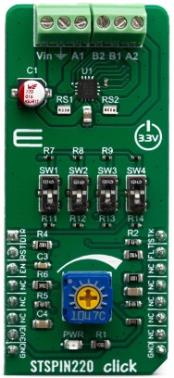
|
|
STSPIN220 click is a stepper motor driver with the PWM current control and selectable microstepping up to 256 microsteps. It is based on the STSPIN220, a low voltage stepper motor driver from STSPIN2 series. It is optimized for battery-powered, low voltage motor driving applications, featuring the lowest standby current available on the market (max 80 nA). The STSPIN220 is a high-efficiency motor driver, featuring low ON resistance MOSFETs as the output stage, in a small 3x3mm QFN package. Its output stage implements the PWM current control with fixed OFF time, along with a full set of protection features. The device can be used with the step motor voltage ranging from 1.8V to 10V, and current up to 1.3A per bridge.
STSPIN220 click is supported by a mikroSDK compliant library, which includes functions that simplify software development. This Click board™ comes as a fully tested product, ready to be used on a system equipped with the mikroBUS™ socket.
|
|
|
|
|
 |
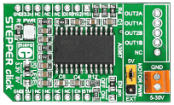
|
|
STEPPER click is a stepper motor driver board in the mikroBUS form factor. It features the A3967SLBT microstepping motor driver, with a built-in translator for easily driving bipolar steper motors in full-, half-, quarter- and eighth-step modes with output drive capability of 30V and about ±500 mA. The package includes a standard B5B-XH-A connector (delivered unsoldered) for easily connecting your stepper motor. The motor can be powered from either the 5V mikroBus line, or from an external power supply (5-30V) using the provided screw terminal connector. The board can communicate with either 3.3V or 5V systems (selection by means of SMD jumper). An LED diode serves as a power indicator. |
|
|
|
 |
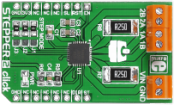
|
|
Stepper 2 click carries a A4988 microstepping motor driver along with screw terminals for connecting a motor and a required external power supply (minimum 7V). The output drive capacity of the motor is up to 35V and ±2A. The A4988 chip is designed to drive bipolar stepper motors in full-, half-, quarter-, eight-, and sixteenth-step modes. A set of three onboard jumpers (J1-J3) allow you to switch between the different stepping modes. The board communicates with the target MCU through EN, RST, SL, ST and DIR pins (corresponding to AN, RST, CS, PWM and INT pins of the default mikroBUS configuration). Stepper 2 click can use both a 3.3V and 5V power supply. |
|
|
|
 |
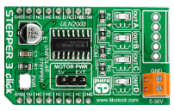
|
|
Stepper 3 click is a mikroBUS™ add-on board for driving unipolar stepper motors with precise controls (individual motor phases can be accessed separately).
The board carries a Texas Instruments ULN2003 High-Current Darlington transistor array for operating the motors.
Motors are connected through a 4-pin male connector on the top of the PCB. They can be driven by the click board's own power supply, or with an external power supply which can be brought through onboard screw terminals (up to 30V).
Stepper 3 click communicates with the target board MCU through mikroBUS™ PWM, AN, RST and CS pins (here used for individual motor phases, marked INA, INB, INC, IND).
The board is designed to use a 5V power supply only. |
|
|
|
 |

|
|
Stepper 4 click can be used for driving a stepper motor and controlling its step resolution, rotation direction, and time between the steps. It has output drive capability of 2A.
The click carries TB67S269FTG, a two-phase bipolar stepping motor driver from Toshiba. Stepper 4 click is designed to run on either 3.3V or 5V power supply. It communicates with the target microcontroller over the following pins on the mikroBUS™ line: AN, RST, CS, PWM, INT. |
|
|
|
 |

|
|
Stepper 5 click is the complete integrated bipolar step motor driver solution, rich with many features that allow silent operation and optimal working conditions for the connected motor. The specialized TM2208 IC driver from Trinamic company far exceeds the capabilities of similar step motor drivers that are commonly used. In order to achieve such outstanding performances with a wide range of various step motors, this device features several technologies: stealth Chop2™ - for silent motor operation; spreadCycle™ - highly dynamic, motor current control; microPlayer™ interpolation with 256 microsteps. |
|
|
|
 |
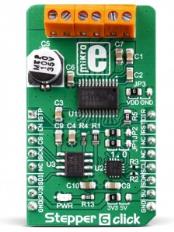
|
|
Stepper 6 click is the complete integrated bipolar step motor driver solution. It comes with the abundance of features that allow silent operation and optimal working conditions for the connected motor. A specialized integrated driver chip on this Click board™ far exceeds the capabilities of similar, commonly used step motor drivers. It comes in the package which also includes the mikroSDK™ software, and a library with all the functions. The Click board™ comes as a fully tested and approved prototype, making it a reliable device ready to use on the development board. Stepper 6 click is a perfect solution for any application that requires an efficient and reliable motor driver. It can be used in 3D printers, laser printers, laser engravers, video security cameras, factory automatization, robotics, and other similar applications. |
|
|
|
 |

|
|
Stepper 7 click is a bipolar step motor driver. It features an H-bridge bipolar step motor driver, which supports full and half step control modes. Stepper 7 click also carries a port expander so that the communication can be done with a minimal number of pins, through the mikroBUS™ SPI bus. Stepper 7 click offers thermal protection, integrated kickback voltage protection, it has a wide range of input voltage, protection against current shoot-through the H-Bridge and reasonably high current capability. These features make Stepper 7 click an ideal solution for driving motors in any application that demands a precise and safe step motor driver. |
|
|
|
 |
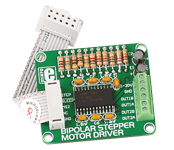
|
|
The Bipolar Stepper Motor Driver Board enables you to add stepper motor control to your applications. There is an on-board microstepping motor driver A3967SLB. The board supports Mixed, Fast and Slow Current-Decay Modes. |
|
|
|
 |

|
|
STSPIN820 click is a stepper motor driver with the PWM current control, selectable microstepping up to 256 microsteps, and a wide voltage range. It is based on the STSPIN820, a stepper motor driver from STSPIN8 series. Designed to be a bullet-proof solution for the new wave of demanding industrial applications, it integrates two full-bridges with low ON resistance, the control logic, and a full set of protection features, in a small 4x4mm QFN package. Its output stage implements the PWM current control with the fixed OFF time. The device can be used with the step motor voltage ranging from 7V up to 45V, and current up to 1.5A per bridge.
STSPIN820 click is supported by a mikroSDK compliant library, which includes functions that simplify software development. This Click board™ comes as a fully tested product, ready to be used on a system equipped with the mikroBUS™ socket.
|
|
|
|
 |

|
|
STSPIN220 click is a stepper motor driver with the PWM current control and selectable microstepping up to 256 microsteps. It is based on the STSPIN220, a low voltage stepper motor driver from STSPIN2 series. It is optimized for battery-powered, low voltage motor driving applications, featuring the lowest standby current available on the market (max 80 nA). The STSPIN220 is a high-efficiency motor driver, featuring low ON resistance MOSFETs as the output stage, in a small 3x3mm QFN package. Its output stage implements the PWM current control with fixed OFF time, along with a full set of protection features. The device can be used with the step motor voltage ranging from 1.8V to 10V, and current up to 1.3A per bridge.
STSPIN220 click is supported by a mikroSDK compliant library, which includes functions that simplify software development. This Click board™ comes as a fully tested product, ready to be used on a system equipped with the mikroBUS™ socket.
|
|
|
|
 |
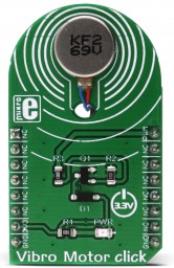
|
|
Vibro Motor click features a compact size Eccentric Rotating Mass (ERM) motor, labeled as C1026B002F. This type of motor is often used for haptic feedback on many small handheld devices, such as the cellphones, pagers, RFID scanners and similar devices. This motor contains a small eccentric weight on its rotor, so while rotating it also produces vibration effect. This kind of motors is sometimes referred to as coin motors, due to its shape.
Besides the vibration motor, the click is also equipped with the DMG3420U, a small MOSFET, which is used to drive the motor. The Vibro Motor click is an ideal solution for adding a simple, one pin driven haptic feedback on any design. |
|
|
|
 |
|
|

